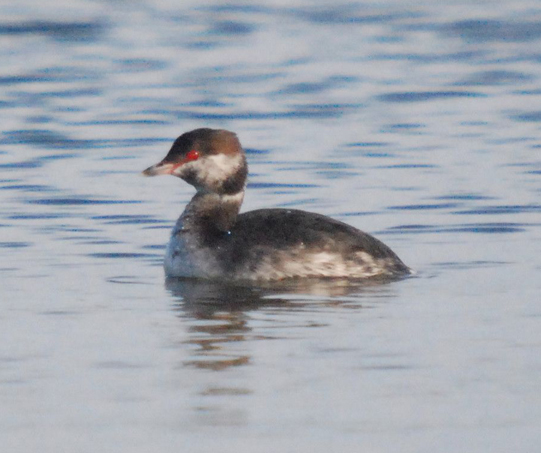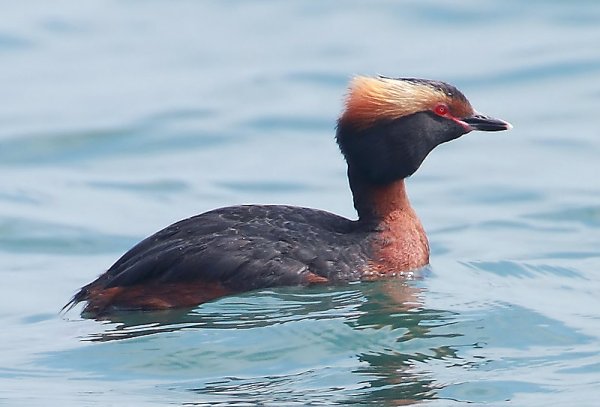Slavonian Grebe
Pociceps a. auritus
Horned Grebe
|
BOU Category:
Site status: Devon status: Conservation status: Conservation levels: |
A
(GB and site)
†
uncommon, sometimes common winter visitor and passage migrant, rare May - Sep uncommon winter visitor and passage migrant to coastal bays and estuaries; rare inland † † BOCC3: amber-listed;† SPEC3 (Declining); Global IUCN (Least Concern) † nationally important: ≥11 (winter); internationally important: ≥55 (winter) † |
International
Different authorities recognise one to three sub-species;
in the Holarctic ‘cornutus’, and the Palearctic has two
forms, the larger-billed ‘arcticus’ and smaller-billed ‘auricus’††.
Form ‘cornutus’ nests in Alaska and Canada, wintering along the Atlantic and Pacific coasts of N America. Form(s) ‘arcticus’/ ‘auricus’ nests across the Palearctic boreal zone east to Kamchatka, mostly 63 - 50°N. Eastern populations winter in China and Japan. It prefers shallow, small, vegetated, freshwater eutrophic or oligotrophic lakes, feeding on arthropods and fish fry. Departure from breeding grounds is mostly Oct/ Nov; failed breeders leave earlier. Not particularly gregarious and seems less responsive than other Pociceps to severe winters, having a tendency to remain at favoured sites all winter on large lakes, estuaries and sheltered coasts, where it preys on fish and some crustaceans. Departure is mostly Mar/ Apr; those with the longest migration not arriving at breeding sites until late-May†.
Europe and Great Britain
Most of Europe’s 6,300 - 11,000 pairs (<25% of the World
population) nest in Iceland, Fenno-Scandinavia, Estonia and Russia†.
First bred Scotland in 1908, where it increased
to a peak of 80 pairs 1978 - 1980,
†
but has since declined to a long-term low
of just 23 pairs in 2011†.
The larger-billed form ‘arcticus’ nests in Iceland, Scotland and N Norway, wintering coastal Iceland, Greenland, W Norway, Northern Isles, NW Scotland and the Irish Atlantic coast. The smaller-billed form ‘auricus’ nests from Sweden eastwards, wintering coastally around W Baltic, southern North Sea, English Channel; also migrates across mid- and E Europe to lakes in France, Switzerland, the eastern Mediterranean, Adriatic, Black, Caspian and Aral Seas†. In the 2000s, the British wintering population was an estimated 1,100 birds (mostly N and W of the Solway), up on previous wintering estimates in the 1980s of 400 birds in Britain and 30 - 40 in Ireland†. The increase in the N (especially Orkney) is possibly due to increase in Icelandic population and the decrease in England possibly reflects a decline in the Fenno-Scandinavian population††.
Devon
Not an uncommon visitor to bays and estuaries since at
least the 19th century, mostly Oct - Apr, peaking Dec - Feb. The
main site is Exe Estuary/ Dawlish Bay, consistently recording the
county’s highest count each winter. Very small numbers winter in
Start Bay, Torbay and Plymouth Sound, and is annually recorded from
other sites along the S coast. Rare on N coast and only 13 inland
records to 2010††.
Dawlish Warren
This is one its best known wintering locations, its status described in 1929 as, “it is most frequent off Dawlish Warren”†. During its peak in the 1970s, when 40 - 50 birds wintered in Devon, and again through its continued decline into the 2000s, the site (including Dawlish Bay) has consistently supported 55 - 90% (average c.70%) of the county’s wintering population.
Since at least the 1960s, the site has each winter supported numbers of national importance and 20 individuals (1984/85-1988/89 mean peak for the estuary) represented 5% of the GB wintering population, a qualifying feature contributing to the designation of Exe Estuary as a Special Protection Area in 1992†.
Worryingly, peak counts have fallen short of the national importance threshold since spring 2006. In 2009 and 2010, the site recorded its lowest yet representations of Devon’s wintering population (down to 33%)†.
The earliest autumn arrivals and only Sep records are five on 24 Sept 1989, four on 30 Sept 1984 and one on 28 Sept 1988. In most years, the first arrivals are mid to late-Oct. There is no autumn passage influx and only twice have isolated double-figure counts occurred; 10 in Oct 1983 and 25 in Nov 1981. Winter maxima are usually in Jan/early-Feb, highest counts are 40 on 18 Feb 1981, 32 on 01 Feb 1989 and 30 in early-Feb 1981. However, the winter peak and start of early spring passage can be indistinguishable. Spring migration usually peaks in early-Mar; the highest counts are 51 on 01 Mar 1980 and 37 in Mar 1975 & 23 Mar 1989. Passage usually tails off into mid-Apr (except since 2008, having ceased by mid-Mar) and the latest have lingered until 04 May 1980 and 06 May 1988 and 1989, the only May records (excepting below).
On 18 Feb 2007, one bird was picked up on the tideline and taken into care, a victim of the MSC Napoli oil-spill. Successfully re-habilitated, it was released on the Exe Estuary where it remained 15 Apr - 05 Nov (except 25 Jun - 09 Aug). However, this particular bird was not knowingly recorded back at Dawlish Warren until 30 Apr 2008 (due to the unusual date). Since then it has remained, mostly in Shutterton Creek and along the main channel off Easton and Starcross, rarely absent for more than a few weeks having relocated further up the Exe Estuary. One wing appears to be damaged and it does not ever quite reach full winter plumage, moulting into summer plumage early in the winter. It was still present in early 2014†.
Annual max count and date(s) 1960 - 2011 (resident bird excluded)
| 1960 | 1961 | 1962 | 1963 | 1964 | 1965 | 1966 | 1967 | 1968 | 1969 |
| 11 | 19 | 9 | 16 | 32 | 20 | 20 | 22 | 23 | n/c |
| e-Feb | 27 Dec | e-Dec | 13 Jan | 22 Nov | 28 Nov | Dec | Mar | 14 Mar | n/a |
| 1970 | 1971 | 1972 | 1973 | 1974 | 1975 | 1976 | 1977 | 1978 | 1979 |
| 30 | 26 | 31 | 25 | 31 | 37 | 25 | 25 | 26 | 26 |
|
early year |
late year |
17 Jan | 25 Feb | Mar | Mar |
early year |
09 Jan | 14 Jan | 18 Mar |
| 1980 | 1981 | 1982 | 1983 | 1984 | 1985 | 1986 | 1987 | 1988 | 1989 |
| 51 | 40 | 27 | 20 | 36 | 28 | 9 | 19 | 17 | 37 |
| 01 Mar | 15 Jan | 26 Mar | 02 Feb | 04 Mar | 28 Mar | 04 Apr | 04 Feb | 17 Jan | 23 Mar |
| 1990 | 1991 | 1992 | 1993 | 1994 | 1995 | 1996 | 1997 | 1998 | 1999 |
| 12 | 17 | 19 | 31 | 18 | 14 | 11 | 19 | 12 | 22 |
| 31 Jan | 27 Dec | 18 Feb | 07 Mar | 31 Jan | 03 Mar |
06 Feb 21-22 Mar |
16 Mar | 05 Feb | 11 Mar |
| 2000 | 2001 | 2002 | 2003 | 2004 | 2005 | 2006 | 2007 | 2008 | 2009 |
| 15 | 18 | 12 | 11 | 12 | 19 | 18 | 10 | 7 | 4 |
| 23 Feb | 29 Jan | 18 Jan | 16 Feb | 24 Feb | 18 Feb | 30 Jan | 01 Feb | 09 Feb | 24 Jan ~ 05 Mar |
| 2010 | 2011 | 2012 | |
| 5 | 7 | 6 | |
|
30 Jan 13 Feb 15 Dec |
20 Mar | 10 Mar |

20/01/2009 © Simon Thurgood
|
Click below to download this page as a pdf  |
Updated 01/02/2014




